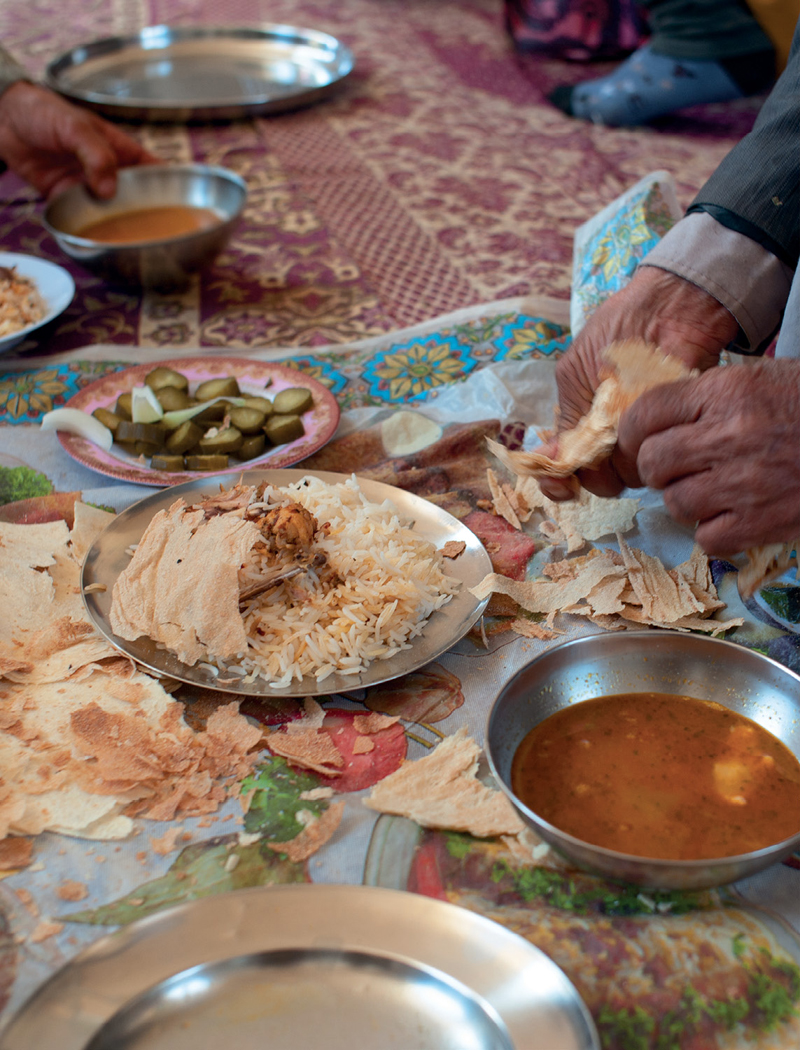

East of Shiraz, Iran—Thin unleavened flatbread called nane-tire accompanies every meal for the Kurds and for the nomads living in the mountains of southern Iran (see here). It’s used to scoop up pieces of meat, sop up gravy, and thicken stews.
The many meat and poultry dishes in the Persian culinary world that are cooked on the stovetop (rather than being grilled or roasted) are an expression of home cooking at its best. Some, like Georgian chakapuli (see recipe), are vibrant combinations of meat and tart fruit, loaded with herbs and greens. Others, for example the wonderful Persian stews called khoresht (see recipes here and here), are slow-cooked and deeply flavored, ideal for eating with plenty of rice to soak up the gravy. Azeri piti (see recipe), called abgusht or dizi in Iran, is a much-loved blend of lamb and vegetables that’s a soup and a meat course in one. In Persian fesanjun (see recipe), chicken cooks in a thick walnut sauce that is tart with pomegranate molasses. There are two easy recipes here for less-favored cuts: a tongue salad from Yerevan (see recipe) that is a satisfying blend of crunch and tenderness, and a richly sauced chicken giblet dish from Georgia (see recipe). Two unusual and easy recipes from Kurdistan call for poaching: Spiced Beef Shank (see recipe) and Fried Chicken in Broth (see recipe).
The recipes that call for lamb, both here and in the grilling chapter, are mostly from the Muslim-majority regions: Iran and Kurdistan, as well as Azerbaijan. There are very few Georgian or Armenian recipes that call for lamb; beef, especially baby beef, is favored.
In this Persian dish, the tartness comes from dried limes, known as limoo omani in Iran and as limoo basrahi in Iraq (see Glossary). The limes add an oddly delicious form of citrus aroma and taste that is one of the distinguishing elements of Persian and Persian-influenced cuisine.
Dried limes are sold in Persian and Arab grocery stores (look for dull-brown rounds), and they keep for a long time in a plastic bag. This recipe calls for both whole dried limes and dried lime powder. You can grate whole limes to get the powder or buy it.
If you’re starting with precooked black-eyed peas, cooking time is less than an hour.
Serves 4 to 6
½ cup dried black-eyed peas, rinsed, or 1½ cups cooked or rinsed canned black-eyed peas (see The Precooked Beans Habit)
4 to 6 cups water
¼ cup plus 2 tablespoons sunflower or extra-virgin olive oil, or rendered lamb fat
2 medium onions, thinly sliced
1 teaspoon turmeric
½ teaspoon freshly ground black pepper, or to taste
About 1 pound boneless lamb shoulder or leg, cut into 1-inch pieces
2 tablespoons tomato paste
1 tablespoon powdered dried lime (see headnote)
2 whole dried limes (see headnote)
2½ teaspoons sea salt, or to taste
3 to 4 medium waxy potatoes, peeled and chopped into ½-inch cubes (about 3 cups)
Juice of 1 lemon
Herb Plate (see recipe)
Sliced tomatoes or cucumbers or a green salad
Basic Persian Rice (see recipe)
If using dried black-eyed peas, place them in a large heavy pot, add about 3 cups of the water, and bring to a boil. Cook at a strong boil, half covered, for about an hour, until the peas are tender.
Meanwhile, heat 2 tablespoons of the oil or fat in a large skillet over medium heat. Add the onions and cook until translucent and starting to brown. Add the turmeric and pepper, then toss in the lamb and stir to expose all sides to the hot oil. Once the meat is touched with color all over, add the tomato paste and turn and stir the meat.
If you are using cooked or canned black-eyed peas, place them in a large heavy pot, add a generous cup of water, and bring to a gentle simmer.
Add the meat and onions to the black-eyed peas. Pour a little hot water into the skillet, swirl it around, and add to the pot, to make sure no flavor is lost. Add water to cover, stir in the dried lime powder, and bring to a boil. Lower the heat to maintain a strong simmer and cook, partially covered, for about 20 minutes.
Prick the dried limes 4 or 5 times each with the tip of a knife (be careful not to cut yourself, since they can ricochet if they’re very hard) and add to the stew. Stir in 2 teaspoons of the salt and simmer for 10 minutes. Set aside.
Meanwhile, heat the remaining ¼ cup oil in a large heavy skillet over medium-high heat. Add the potatoes and the remaining ½ teaspoon salt and cook, stirring frequently, until the potatoes are crisp and golden all over, about 10 minutes. Drain.
Just before serving, reheat the stew and stir in the lemon juice. Taste for seasoning and adjust it if you wish. Divide the stew among individual wide bowls or plates and top with the fried potatoes. Serve with the herb plate, sliced tomatoes (or cucumbers or salad), and rice.

Massouleh, Iran—Legumes are widely used in Persian cooking, especially in the delectable soup-stews called ash (see recipes here, here, and here). Here, from left to right, are white beans, lentils, black-eyed peas, and split peas.
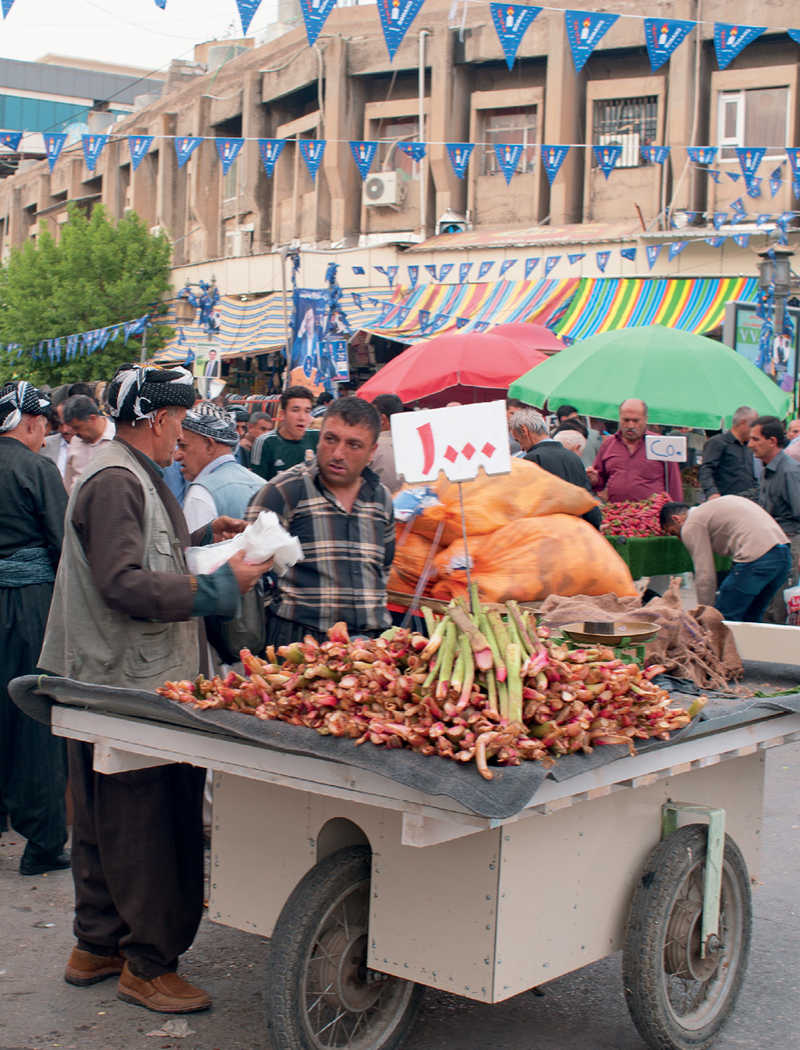
Sulaymaniyah, Kurdistan—The streets in the bazaar area downtown are crowded with shoppers in the evening, most of them men picking up meat, vegetables, and breads to take home. The vegetable for sale here is a cousin of rhubarb and available for only a short time in spring.

Chakapuli is a vibrant, easy stew, green with tarragon and the tartness of sour plums (tkemali in Georgian), for which tomatillos are an ideal substitute. Like most meat dishes from Georgia, it is usually made with meat from young cattle. At Eastertime, though, there’s a special version of chakapuli made with lamb.
Serve as a main course with one of the Persian rices here through here, or with boiled potatoes. Include a vegetable dish or two, such as Georgian Leek Pâté (see recipe) and Azeri Mushrooms (see recipe).
Serves 6
2 to 3 tablespoons sunflower or extra-virgin olive oil
1 cup chopped onion or shallots
¼ teaspoon turmeric
About 2 pounds boneless lamb shoulder or leg or baby beef rump roast or shoulder (see headnote), cut into bite-size pieces
4 to 5 cups water
About 12 sour plums, or substitute tomatillos, husked and rinsed
½ cup chopped scallions (including the green tops)
1 cup fresh tarragon leaves
¼ cup chopped fresh coriander
2 tablespoons minced lovage (optional)
1 tablespoon powdered dried fenugreek leaves
2 garlic cloves, minced or mashed, or ½ cup chopped fresh garlic chives
1 dried red chile or fresh green cayenne chile, broken or halved, or 1 teaspoon cayenne
1 teaspoon sea salt, or to taste
About ¼ cup dry white or red wine
Place a wide heavy pot over medium-high heat. Add the oil, and when it is hot, add the onion or shallots and sauté until softened. Add the turmeric and stir. Add the meat and cook, stirring occasionally, until it has all changed color, about 5 minutes. Add water to cover, raise the heat, and bring to a boil. Lower the heat and simmer, partially covered, for 30 minutes if using lamb (1 hour if using beef).
Add the plums or tomatillos, bring to a strong simmer, and cook for 20 minutes. (The dish can be made ahead to this point, covered, and set aside until 30 minutes before you want to serve it. If holding it for longer than an hour, refrigerate it after it cools; bring to a simmer before proceeding.)
Toss in the scallions, tarragon, coriander, lovage, if using, fenugreek, garlic, chile or cayenne, and salt and stir well. Simmer for about 10 minutes, covered. Add the wine. Simmer for another 10 minutes, uncovered.
Taste for seasoning and adjust if necessary just before serving.
I am still haunted by the gormeh-sabzi I had at a little eatery near the entrance to Kerman’s bazaar. Its gravy had a deep meaty flavor with a subtle edge of tamarind tartness. This is my homage to that stew.
Like most stews, this tastes best if made ahead (refrigerate if the wait is longer than an hour), then reheated when you want to serve it. Hold back on the final seasoning until the last moment: You may want to add a squeeze of lemon at that point. Or instead serve lemon wedges alongside.
Serves 4
½ cup dried black-eyed peas, rinsed
About 8 cups water, plus 2 to 3 tablespoons
5 to 6 tablespoons sunflower or vegetable oil or rendered lamb fat
1 large bunch coriander, trimmed and finely chopped (2 packed cups)
1 to 2 bunches flat-leaf parsley, trimmed of coarse stems and finely chopped (2 packed cups)
½ cup chopped fresh dill or 2 tablespoons dried dill
½ cup chopped fresh fenugreek or 2 tablespoons dried fenugreek leaves
1 large or 2 medium leeks, white and pale green parts only, chopped and washed well (2 to 3 cups)
¼ teaspoon turmeric
1 large or 2 medium onions or 2 large shallots, thinly sliced
About 1 pound boneless lamb shoulder, cut into 1-inch pieces
2 tablespoons powdered dried lime, or about 2 tablespoons fresh lemon juice
2 teaspoons sea salt, or to taste
1 tablespoon tamarind pulp
4 dried limes
1 or 2 lemons, cut in half
Basic Persian Rice (see recipe)
Herb Plate (see recipe)
Place the black-eyed peas in a pot, add about 3 cups water, and bring to a strong boil. Partially cover, lower the heat slightly, and boil for 30 minutes or so while you prepare the herbs and meat. Check occasionally to make sure that the pot isn’t too dry; add more water if necessary.
Place a wide heavy pot over medium-high heat. Add about 3 tablespoons of the oil or fat, then toss in all the herbs and the leeks and cook, stirring frequently, for a minute or two. Reduce the heat to medium-low and cook, stirring occasionally, until the herbs and leeks are very wilted and their color has darkened, 15 to 20 minutes; add a little extra oil if they start to stick. Transfer to a bowl and set aside; place the pot back over medium-high heat.
Add 1 to 2 tablespoons oil or fat to the pot, then add the turmeric and stir. Toss in the onions or shallots and cook until well softened. Raise the heat, add the meat, and cook, stirring and turning it, until all surfaces have changed color, about 5 minutes. Add the cooked herb mixture, the softened black-eyed peas with their cooking liquid, and the dried lime powder or lemon juice and stir well. Add hot water to cover generously, about 3 cups, and bring to a boil. Add 1 teaspoon of the salt, lower the heat to maintain a strong simmer, and cook, covered, for an hour or so.
Meanwhile, cut the tamarind pulp into pieces and place in a bowl with 2 to 3 tablespoons hot water. Use a fork to mash it to help it dissolve in the water. Set aside to soak for 15 minutes or so, then mash it a little more. Place a sieve over a bowl, pour in the tamarind mixture, and use the back of a spoon to press it through the mesh. Discard the tamarind debris and set the tamarind liquid aside.
At this point, the meat and black-eyed peas should be very tender. Prick the dried limes several times with the tip of a knife (be careful not to cut yourself, since they can ricochet if they’re very hard) and add them to the stew, along with the remaining 1 teaspoon salt. Cover and simmer for about 50 minutes, checking occasionally to make sure that the stew is not sticking to the bottom of the pot—add water if needed—and that the dried limes are immersed in the liquid; press down on them if need be.
Add the tamarind liquid. There should be plenty of thin dark gravy; if the stew has thickened, add more water. Cover and simmer for about 10 minutes longer.
Taste for salt and for tartness; adjust as necessary, with salt and squeezes of lemon juice. Serve with the rice and herb plate.
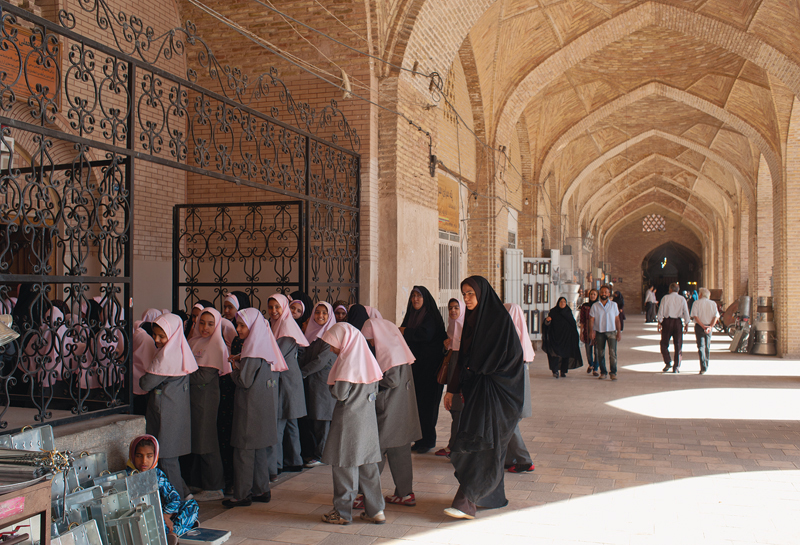
Kerman, Iran—The tall, graceful vaulted roof of the Kerman bazaar dwarfs this group of schoolgirls on an outing.
Called abgusht in Persian (ab means water or liquid, and gusht means meat), but known casually as dizi in Iran and piti in Azerbaijan, this stew of lamb and chickpeas comes in many versions. It’s a peasant dish, often served at workingmen’s cafés and at market stalls as a hearty affordable meal-in-a-bowl.
The name dizi comes from the word for the deep, straight-sided iron bowl used for serving the stew in Iran. Traditionally the stew was cooked in an earthenware pot. In Azerbaijan, piti comes in an earthenware pot, and in both Azerbaijan and Iran the basics are the same: a brothy lamb stew with chickpeas, chunks of potato, and a little tomato, served very hot. The traditional tools for eating it are a spoon, a pestle, flatbread, and an empty bowl.
The first time you are served dizi, whether by a home cook or in a café, you have to figure out how to eat it. The broth and solids are served together but are eaten separately. Start by tearing up some flatbread into the empty bowl and pouring the broth over it to make your “first course.” After you have spooned up the broth and soaked bread, it’s time for part two: Mash the meat, chickpeas, and potato to a coarse paste with the pestle (or the back of a large spoon), then scoop up the paste with more flatbread, taking the odd bite of fresh herbs or sliced onion from time to time as a refresher.
For the cook, the most important ingredient is time, a long, slow boil and simmer to get the meat and chickpeas tender and the flavors blended. Many cooks in Iran use a pressure cooker to speed up the cooking of the chickpeas. I prefer to put the stew on well ahead and let it cook slowly, without worrying about it. I make it with lamb shanks or even bone-in lamb chops; the marrow in the bones adds extra richness. You can start with boneless lamb, but in that case, be sure to include some chunks of lamb fat.
This recipe makes a large amount; when serving fewer people, I still make the whole batch, just to have the leftovers. As with most stews, it is even better the next day.
Serves 8
3 pounds bone-in lamb (chops, or shank cut into short lengths) or 2¼ pounds boneless lamb shoulder or leg
A few chunks of lamb fat (optional; see headnote)
2 medium onions, chopped
1 cup chickpeas, soaked for at least 3 hours, or overnight, in water to cover and drained
½ cup dried navy beans or other white beans
1 dried lime (optional)
1 cassia (cinnamon) stick
½ teaspoon turmeric
2 teaspoons sea salt, or to taste
About 1½ pounds waxy potatoes, peeled and cut into 1½-inch chunks
2 medium tomatoes, coarsely chopped, or ½ cup canned crushed tomatoes
6 dried sour plums (optional; see Note)
1 tablespoon dried mint (optional)
Lavash or other flatbreads
2 thinly sliced onions (optional)
Ground sumac (optional)
Herb Plate (see recipe; optional)
Place the lamb, lamb fat, if using, onions, chickpeas, and beans in a large heavy pot, add water to cover, and bring to a vigorous boil. If using the dried lime, prick it several times with the tip of a knife (be careful not to cut yourself, since it can ricochet if it’s very hard), and toss it in. Add the cassia, turmeric, and salt. Lower the heat to maintain a medium boil, partially cover, and cook for 2½ hours, or until the chickpeas and beans are tender. If the water level drops during the long cooking, add more.
Add the potatoes, tomatoes, and sour plums, if using, and cook until the potatoes are tender, about 20 minutes. Taste for seasoning and adjust as needed.
Serve in large bowls, topped with a sprinkling of dried mint if you wish. Put out the flatbreads and whatever other accompaniments you choose. Give each guest a large extra spoon and an extra bowl, and explain how the dish is eaten.
Note on Choices and Differences: In Azerbaijan, I had several versions of piti that included sour plums, which is why they are an option here. The sliced onions and sumac are served with Azeri piti but not usually with Iranian dizi. Instead, in Iran, the stew is served with a simple plate of scallions and fresh herbs.
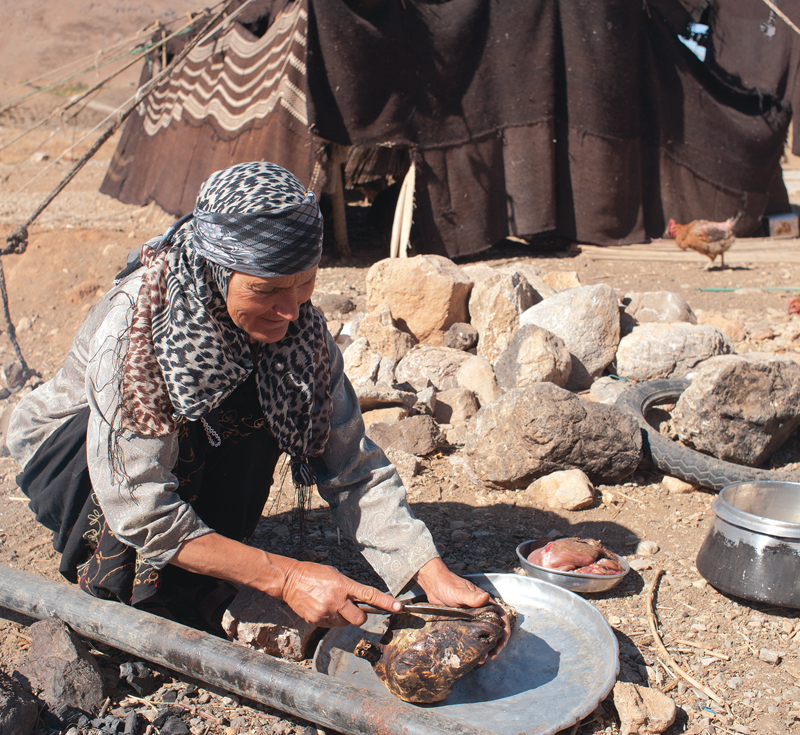
East of Shiraz, Iran—I arrived at this nomad encampment in the mountains when the matriarch of a large family was preparing kaleh poche, a stew of sheep’s head and shanks. Here she is cleaning the sheep’s head carefully, before adding it to the pot.
In Iran and Azerbaijan, butchers’ shops routinely display clean, gleaming-white sheeps’ heads and shanks in tidy rows. They’re the essential ingredients for making kaleh poche, which means “head and shank” in Persian. It’s a frugal dish and a favorite of home cooks. It originated as a way of making use of the bits left over when a sheep was slaughtered, and that’s how I first encountered it in Iran, on the day after Eid e-Ghorban, the Feast of the Sacrifice.
Elsewhere in the Muslim world, the Feast of the Sacrifice is a time when sheep or cattle are butchered and the meat shared at family feasts. Persians had told me that in Iran the feast is celebrated by only a few, families of those who have made the pilgrimage to Mecca (the haj).
Up in the mountains, about three hours’ drive from Shiraz, lives a group of nomads known as Khamseh. They have a mixed heritage, partly Arab, and among themselves, they speak a form of Arabic, rather than Persian. They keep herds of sheep and goats, and a few of the wealthier families keep a camel.
Every fall in late October before the cold weather sets in (there is heavy snow in the mountains in the winter months), the Khamseh families set off on foot—with their herds and their donkeys, which are loaded with household goods—on a twenty-day journey south through the mountains to their winter pastures above the port city of Bandar Abbas. There they set up their dark wool tents. Winter is the time for dyeing the wool that the women have spun in the summer months, and for weaving their lovely rugs. After Nou-Roz (the Iranian New Year, at the spring equinox), they pack up and head back north to their summer pastures.
When I stayed near the mountains, my host, Abbas, took me up to visit the nomads. His second wife, Leila, came with us; it was her family we were going to visit. When we arrived, her mother, Heshmat, was hard at work cleaning the head and legs of a sheep, which were about to be transformed into kaleh poche. The family patriarch, Hajji Hossein, had made the pilgrimage to Mecca some years earlier. As a result, the whole family and their neighbors had celebrated Eid the day before; the head and legs were all that remained after the feast.
I photographed Heshmat as she worked out in the sunshine and clear air. Once she had the head and shanks thoroughly cleaned and cracked open, they all went into a large pot of boiling water with salt, turmeric, chopped onion, a little tomato, and wild-gathered aromatics.
Nearby was the family tent, woven of black-brown wool and hung over a light frame to make an airy shelter from the sun. But the family also has a one-roomed brick house with a door and a thickly carpeted floor. It was there that we ate. We sat around the sofreh, a sheet of plastic placed over the carpet, onto which went piles of thin unleavened saj-baked breads like those in Kurdistan, which both the nomads and Kurds call nane-tire (see recipe). Hajji Hossein was served first by his wife. As the guest, I was next; then she served her sons, and finally her daughters. The bones had been transformed into a rich broth that was served in individual bowls. We ate by dipping pieces of bread into our soup, and we also used it to pick up morsels of meat from a shared platter. Each mouthful was a pleasure. Leila had brought a chicken dish and rice to contribute to the meal, but I stuck with the kaleh poche.
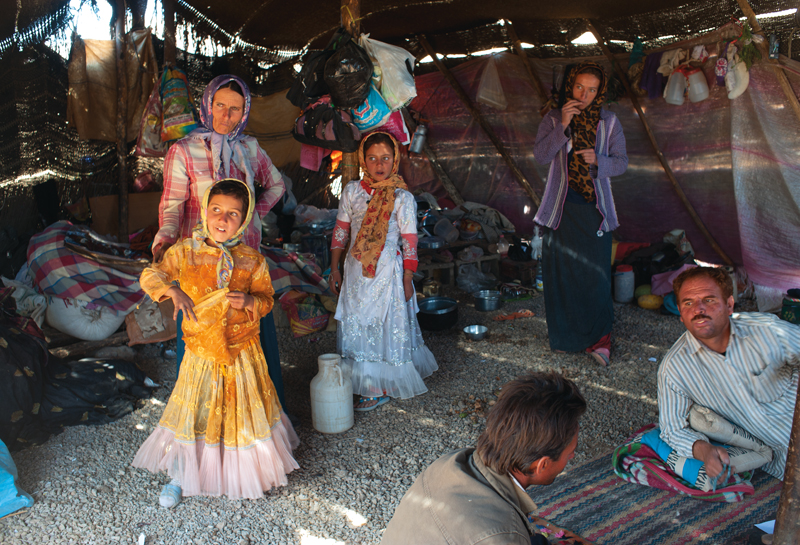
East of Shiraz, Iran—A family at a nomad encampment in its large, airy tent. The tent frame of light poles that are lashed together holds wool fabric woven from the family’s sheep. The two girls taught me a game resembling jacks, played with small stones.
This easy stew is traditionally made with water, but if you have vegetable or meat broth, use that instead for extra depth of flavor. The baharat (spice blend) is simple: turmeric, cumin, and nigella. Dried apricots or dried plums add a tart note.
In Kurdistan, cooks prefer to use meat that is finely chopped (gosht e narim means chopped meat), not ground. You can start with a pound of flank or similar steak, or boneless lamb shoulder or chicken breast, and chop it, but I suggest you take the easy way, as I do, and use ground meat.
Serves 6
¼ cup sunflower or extra-virgin olive oil
½ teaspoon turmeric
2 teaspoons ground cumin
1 teaspoon nigella seeds or ground nigella
1 pound ground beef, lamb, or chicken
2 cups cooked or rinsed canned split peas (see The Precooked Beans Habit)
1 tablespoon tomato paste
¾ cup dried apricots or dried plums, coarsely chopped
3 medium waxy potatoes, peeled and cut into 1-inch-long wedges
About 6 cups water or broth (see headnote)
2 teaspoons sea salt, or to taste (less if using salted broth)
Flatbreads
Herb Plate (see recipe)
Kurdish Black Rice (see recipe), Kurdish Red Rice (see recipe), or Basic Persian Rice (see recipe)
In a wide heavy pot over medium heat, heat the oil until hot. Add the turmeric, cumin, and nigella and cook for a moment, stirring. Add the meat, split peas, tomato paste, and dried fruit and stir to expose all surfaces to the hot oil. Add the potatoes and enough water to cover by ½ inch and bring to a boil. Add the salt, partially cover, lower the heat, and simmer for 20 minutes, or until the potatoes are tender. Taste and adjust the seasoning if you wish.
Serve hot or warm with the flatbreads, fresh herbs, and rice.
In Victorian times there was a tradition of spiced beef in England and North America, but it has largely disappeared. Spiced beef is not only delicious, but also a great way of using a tougher cut of meat (those that often have better flavor). I tasted this dish in Sulaymaniyah at the home of a political activist named Shler. The meat is simmered in spiced water, then set aside to cool. (I often cook it the day before I want to serve it.) Serve it in slices at room temperature as part of a meal, as I had it in Kurdistan, or use for open-faced or regular sandwiches.
I love having a supply of spiced beef on hand for unexpected guests or random hungry people. Serve it with plenty of good bread, plain or buttered, and something crunchy and fresh, such as sliced cucumber or pickles of some kind. Put out a condiment such as Georgian spice paste (ajika; see recipes here and here) or Dijon mustard if you wish.
Serves 6 to 8 as part of a meal
3 cups water
1 tablespoon whole cloves
1 teaspoon allspice berries
1 tablespoon cardamom pods, cracked
1 tablespoon black peppercorns
A 2- to 3-inch cassia (cinnamon) stick, broken into 2 or 3 pieces
3 or 4 large garlic cloves, coarsely chopped
1 teaspoon sea salt
About 2 pounds young beef or ethical veal shank or tendon, cut into short lengths by the butcher
Pour the water into a heavy pot, add the spices, garlic, and salt, and bring to a vigorous boil. Partially cover and boil for 10 to 15 minutes.
Add the meat, cover, and cook at a low boil until the meat is cooked through and tender, about 20 minutes. Remove the meat and set aside on a plate to cool to room temperature. (You can refrigerate it, in a sealed container, for up to 4 days.)
Serve the meat at room temperature, thinly sliced across the grain and arranged on a plate.
Tongue can seem intimidating if you have never cooked it, but it used to be a very normal cut for home cooks. It’s still part of life in many places outside North America. When properly cooked and thinly sliced, it is tender and a pleasure to eat, rather like thinly sliced smoked meat. It must be poached until very soft, which takes 2½ to 3 hours. It’s not possible to overcook tongue; if you’re in doubt, let it cook a little more. The skin should be peeled off right away, while the tongue is still hot, or the job will be more difficult.
Tongue is usually served cold or at room temperature. Poach it ahead and store it in the refrigerator, bathed in the poaching liquid, so you can easily slice it thin and use it in anything from sandwiches to salads (see Yerevan Tongue Salad).
I used Jennifer McLagan’s poached tongue recipe in her book Odd Bits for guidance; this recipe follows her method but with a different set of flavors in the poaching liquid.
1 small beef tongue (2½ to 3 pounds)
1 medium onion, coarsely chopped
1 tablespoon sea salt
4 whole cloves
8 allspice berries
1 thyme sprig or ½ teaspoon dried thyme (optional)
2 bay leaves
1 cassia (cinnamon) stick, broken in half
Place the tongue and onion in a large pot. Add water to cover by about 2 inches and the salt and bring to a boil. Skim off and discard the foam or scum that rises to the surface. Toss in the cloves, allspice, thyme, if using, bay leaves, and cassia stick, lower the heat to maintain a strong simmer, and cook, partially covered, until the tongue is very tender, 2½ to 3 hours. Top off the water if the level drops below the top of the meat, and turn the tongue over after about 1½ hours. To test for doneness, use a fork to pierce the tongue at both the thick end and the tip—it should slide in easily in both places.
Lift the tongue out of the broth and onto a plate or cutting board; set the poaching liquid aside. It is much easier to slide the skin off the tongue when it is hot. Work with a bowl of ice cubes nearby so you can cool your fingers from time to time, or use latex gloves to protect your hands from the heat. Start at the thick (throat) end of the tongue and use a small knife to pry an edge of the skin loose. Take hold of the loose edge with your fingers and then peel the skin off. It will come off in large strips. Trim off and discard any fat or gristle (there will be some at the thick end of the tongue).
Strain the poaching liquid into a container with a lid. Place the tongue in the broth, cover, and refrigerate for at least several hours, until completely chilled. It can be refrigerated for up to 4 days.
To use the tongue, slice crosswise as thin as possible.
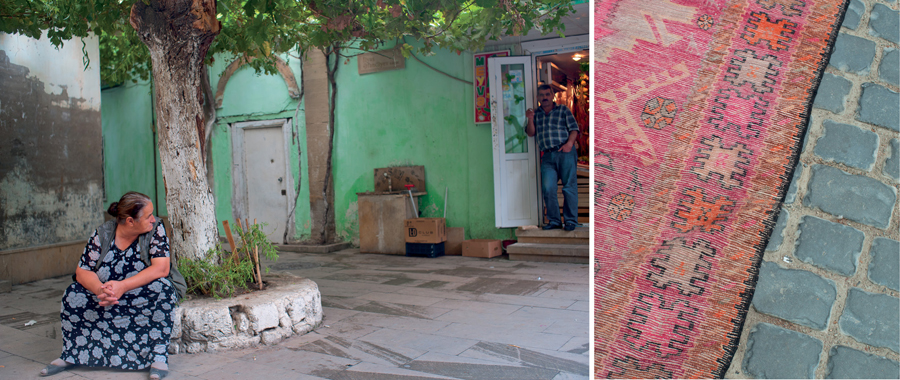
Baku, Azerbaijan—A small inviting square in an area of the old city not yet transformed into expensive apartments and shops (left). A carpet laid on the cobblestone street outside a shop in the old city (right).
This is my reconstruction of an appealing dish that I ate at a restaurant in Yerevan called Karas. It’s made with slices of tender poached tongue tossed with red pepper, onion, and herbs.
The crunch of the red bell peppers and the cornichons is a nice contrast with the tender slices of tongue. If you don’t want to use cornichons, try another pickle, such as Iranian-style pickled radishes, and chop them. Sorrel, with its lemony edge, is a great addition, along with the fresh tarragon or coriander.
Serves 6 as an appetizer or a side dish
1 onion, thinly sliced
About 1½ teaspoons sea salt
About ½ pound poached baby beef or veal tongue (see Poached Tongue), chilled
1 medium red or yellow bell pepper, cored, seeded, and cut into strips about ¼ inch wide and 1 inch long
10 cornichons, halved lengthwise (see headnote)
2 tablespoons red wine vinegar, or to taste
1 teaspoon sunflower or extra-virgin olive oil
About 2 tablespoons fresh tarragon leaves or chopped fresh coriander
3 or 4 sorrel leaves, cut into chiffonade, or substitute 2 tablespoons chopped fresh flat-leaf parsley plus 1 teaspoon ground sumac
Place the sliced onion in a bowl and sprinkle on about 1 teaspoon salt. Let stand for 15 minutes. Rinse the onion thoroughly in a sieve and gently squeeze it dry. Set aside.
Thinly slice the tongue, cut the slices into narrow bite-size strips, and transfer to a shallow bowl. Add the onion, bell pepper, and cornichons.
Mix the vinegar and oil with about ½ teaspoon salt and pour over the salad. Turn and toss gently. If you have the time, set aside for 30 minutes, loosely covered, to allow the tongue to absorb the other flavors and come to room temperature.
Just before serving, taste for salt and adjust if necessary. Sprinkle on the fresh herbs and toss again.
Kharcho is classic comfort food from Georgia. It’s originally from mountainous Samegrelo and has the punchy flavors characteristic of that region. The beef cooks with onions and tomatoes. A paste of ground walnuts blended with garlic and spices enriches the gravy.
Though kharcho is usually served with breads, either Boomerang Breads (see recipe) or khachapuri (see recipe), I like serving it with rice.
Serves 6 to 8
¼ cup sunflower or extra-virgin olive oil
4 cups chopped onions (4 to 5 medium onions)
About 2 pounds stewing beef or pot roast, cut into bite-size pieces and trimmed of gristle and excess fat
2 tablespoons tomato paste
About 2½ cups water
2 cups chopped tomatoes (about 5 medium) or chopped canned tomatoes
1 cup finely ground walnuts
½ cup hot water
4 garlic cloves, crushed
1 tablespoon Georgian Spice Blend (see recipe)
1 teaspoon cayenne (optional)
About 2 teaspoons sea salt
Freshly ground black pepper
¼ cup fresh coriander leaves
In a large heavy pot, heat the oil over medium-high heat. Toss in the onions and cook for a few minutes, until just starting to soften. Add the meat and stir, turning to expose all surfaces of the meat to the hot oil. Add the tomato paste and 2 cups water and bring to a boil, then lower the heat and simmer, partially covered, for 30 to 40 minutes.
Add the tomatoes and another ½ cup water and cook, partially covered, until the meat is tender, another 1 to 1½ hours. Stir again.
Once the meat is tender, place the walnuts in a bowl, add the hot water, and stir to blend to a paste. Add the garlic, spice blend, cayenne, if using, salt, and pepper to taste, then add the paste to the stew and stir in. Simmer for another 10 minutes. Taste for seasoning and adjust if necessary. Serve the stew sprinkled with the coriander leaves.
Kurdish Fried Chicken in Broth, with Barberry Rice (see recipe).
I love this style of cooking chicken for both its flavor and its ease. The chicken is cut into pieces and rubbed with salt and lemon juice, kind of a quick marinade, before being shallow-fried until golden. But there’s no worry about whether the frying cooks the chicken completely, because it then simmers in water with a little onion, turmeric, and cumin until tender and cooked through.
Serve with rice and fresh herbs.
Serves 6 to 8
2½ to 3 pounds bone-in chicken legs and/or breasts, chopped into 1½-inch to 2-inch pieces
About ¼ cup fresh lemon juice
2 teaspoons sea salt, or more to taste
About 1½ cups sunflower or extra-virgin olive oil for shallow-frying
2 medium onions, grated
½ teaspoon turmeric
1¼ teaspoons ground cumin
¼ cup finely chopped fresh coriander or scallions, or a mixture
Flatbreads
Kurdish Red Rice (see recipe) or Kurdish Black Rice (see recipe)
Herb Plate (see recipe)
Place the chicken pieces in a large bowl, add the lemon juice, and turn the chicken to expose all surfaces to the juice. Add the salt and rub it onto the chicken pieces. If you have time, refrigerate, covered, for an hour or two to marinate.
About an hour before you want to serve the chicken, place a wide heavy skillet over medium heat. Add oil to a depth of ¼ inch. Once the oil is hot, lift the chicken pieces out of the marinade (reserve the marinade) and carefully slide them into the oil. (If your pan is too small to hold the chicken comfortably, use two pans or cook in batches, adding a little more oil if necessary.) Fry, turning the pieces from time to time, until the chicken is well touched with gold, about 15 minutes.
Lift the chicken pieces out of the oil and transfer to a large pot. Add the onions, the reserved marinade, and water to barely cover. Bring to a boil and toss in the turmeric and cumin, then lower the heat and simmer gently for 45 minutes or so, until the chicken is cooked through. (If you taste the broth early in the cooking, you will find the cumin too strong, but once it has finished simmering, the flavors come together.) Taste for seasoning and adjust if necessary.
Serve the chicken in its broth, topped with a sprinkling of chopped coriander and/or scallions. Set out plenty of flatbreads, the rice, and the herb plate.
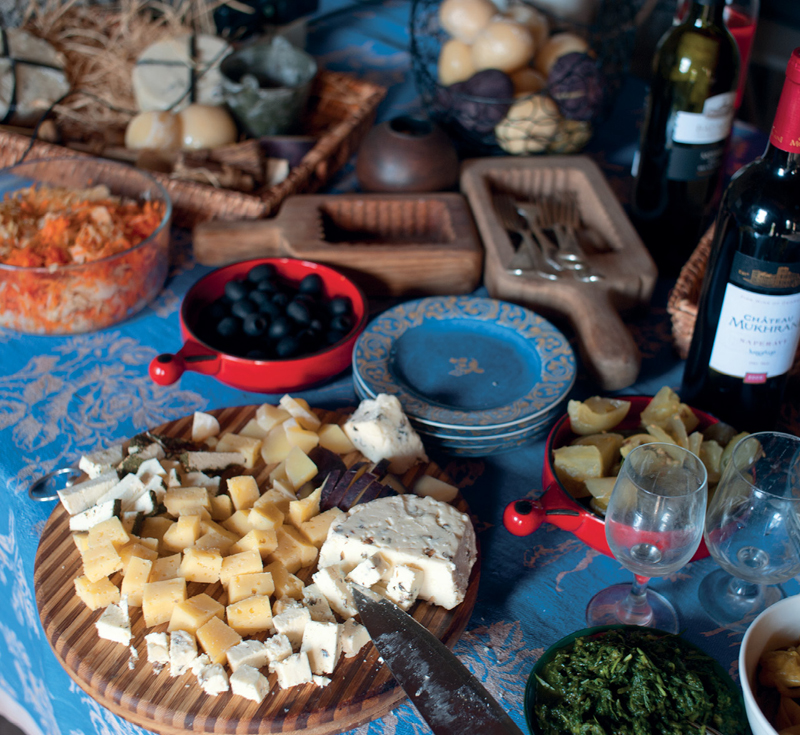
Near Tbilisi, Georgia—A casual spread of cheese, wine, and more set out in a farmhouse kitchen.
Late one spring afternoon, a friend and I made our way to dinner at the apartment of a family that I’d met only the week before. They live in the Tbilisi suburbs, in a tall apartment-block landscape like that of many former Soviet cities. The blocks are charmless on the outside, and access is usually through a cement entryway that leads to a chipped concrete staircase, and perhaps to an elevator that may or may not work.
We climbed up to the fourth floor and found the apartment of our hosts, which was charming and inviting. The table had been set with plates, glasses, and clay ewers of Georgian wine, as well as with some of the dishes that were to be part of our meal: khachapuri (cheese-filled flatbreads), Boomerang Breads (see recipe), two kinds of ajika, red and green (see recipes here and here), a leafy green salad, and more.
In Georgia, an enormous effort goes into preparing food and laying a generous table for friends and family—and occasional strangers from afar like me. Though the work, almost all of it done by women, is long, it happens not in a rush but with a kind of easy stamina. Supper will be ready when it’s ready, not at some exact preappointed time. The waiting time will pass with conversation and joking around. It’s all part of a kind of unstructured style in Georgia that I find welcoming and relaxing.
After a while, our hosts brought more dishes to the table and we all sat down to the feast. Gia was tamada, or table host, and he proposed the first toast of the evening, the classic opener, “To God.” We went on from there to eat and drink and tell stories. Several late arrivals were specially toasted in welcome. The toasts, the joking, the food explanations (translated for me by my friend Tamar), and the shifting conversations during the meal were all part of an in-the-moment delight. To Georgians, what matters most is coming together to eat and drink, finding pleasure and warmth at the table.
Ask an Iranian about Persian food, and for sure you’ll be told about fesanjun. People have strong feelings about it. I took a cookbook with me to Iran, Margaret Shaida’s classic The Legendary Cuisine of Persia, published in 1992. Her recipe for fesanjun puzzled me, because it calls for sugar as well as onion. When I found myself in Farahnoz’s kitchen (see Caspian Interlude), I asked her about the sugar. “Oh, she must be from Tehran!” she said immediately. “Fesanjun is from here, from the north. It should be sour, with no sugar or onion, and intense with pomegranate.”
This recipe follows her advice. Pomegranate molasses cooks down with ground walnuts to make a dark, intense sauce, and the chicken cooks in the sauce for about 45 minutes.
Cooks and eaters also differ about the texture of the walnuts: Should they be finely ground, or instead left a little coarser?
Serve this as the centerpiece of a meal, with Basic Persian Rice (see recipe) or another plain rice.
Serves 6 to 8
2½ cups (8 ounces) walnuts or walnut pieces
4 cups lukewarm water
½ cup pomegranate molasses
½ teaspoon ground cassia (cinnamon)
1 teaspoon sea salt
3½ pounds bone-in chicken legs, each cut into 4 pieces (with a cleaver or sharp heavy knife), or 2½ pounds boneless legs and breasts, cut into large bite-size pieces, skin removed
About 1½ teaspoons salt
Generous grinding of black pepper
To make the sauce, grind the walnuts in a food processor or other grinder until they are fine crumbs, not a powder. Place them in a bowl, add the lukewarm water, and stir to mix thoroughly. Set aside.
Place a wide heavy pot over medium heat. Add the pomegranate molasses and heat, stirring, until it starts to bubble. Add the water-walnut blend and stir as it all comes to a boil, then lower the heat and cook at a low boil for about 1 hour, uncovered. Check occasionally to make sure that the sauce is not burning as it cooks down, just thickening a little; add another ½ to 1 cup water if necessary. The sauce will darken in color as it cooks, and the oil from the walnuts will rise to the surface.
Meanwhile, make the chicken: If using skin-on chicken, pull off the skin and set aside for another purpose if you wish.
Place the chicken in a bowl, sprinkle on the salt and pepper, and toss to distribute the seasonings. Cover and refrigerate.
Once the sauce has cooked for a full hour, it should have reduced to about 2½ cups. (The sauce can be made up to 1 day ahead to this point. Bring back to a low boil before proceeding.)
Add the cassia and salt to the sauce, then add the chicken, partially cover the pot, and bring back to a low boil. If the sauce does not cover the chicken, add a little water so that it does. Cook partially covered, stirring occasionally, until the chicken is cooked through, about 45 minutes for bone-in chicken and a little less for boneless.
Serve hot or warm with rice.
Prepare the sauce as above, cook at a low boil for about 1½ hours, until reduced to 2½ cups, and set aside. On the skin side of boneless duck breast (about 2 pounds total), make parallel slashes through the skin to the fat. Rub on salt and pepper. Heat a cast-iron skillet over medium heat and place the breasts skin side down. Gradually raise the heat to high as they cook for 7 to 8 minutes, releasing their fat; add some of it to the sauce. Set the breasts aside to rest for 10 minutes. Slice thinly and cut into bite-size pieces. Just before you want to serve, reheat the sauce, then add the duck and cook for 2 or 3 minutes.
Kuchmachi, a kind of warm meat salad, is aromatic with spices and rich with walnut paste. The chicken version includes livers, hearts, and gizzards, but since gizzards are no longer readily available, they’re optional in this recipe. (The pork and beef versions include hearts, livers, kidneys, spleen, and lungs. If you want to make the beef or pork version, you will need to increase the cooking time.)
The giblets simmer until tender, then are dressed with a sauce of ground walnuts blended with spices and a little vinegar. My Georgian friends tell me that dried thyme is an essential ingredient, but I have seen recipes that call for summer savory rather than thyme.
Serve this as a main course with a vegetable dish and a fresh salad alongside, or serve as an appetizer with bread.
Serves 4 as a main course, 6 to 8 as an appetizer
½ pound chicken livers
½ pound chicken hearts
¼ pound chicken gizzards (optional)
2 tablespoons sunflower or extra-virgin olive oil
2 red onions, 1 thinly sliced, 1 finely chopped
About 1½ cups water
1 bay leaf
3 small garlic cloves, 1 sliced, the others coarsely chopped
¾ cup walnuts or walnut pieces
1 to 2 tablespoons white or red wine vinegar, to taste
1 tablespoon Georgian Spice Blend (see recipe)
1 teaspoon dried thyme or summer savory
1 teaspoon powdered dried red chiles or cayenne
1½ teaspoons sea salt, or to taste
¼ to ½ cup loosely packed chopped fresh coriander or tarragon
Thoroughly wash the chicken livers, hearts, and gizzards, if using, and pat dry. Chop into ½-inch pieces and set aside.
In a wide heavy pot, heat the oil over medium heat. Add the sliced onion and cook, stirring occasionally, until very soft but not at all tinged with color. Add the chopped giblets and stir for a minute to coat with the hot oil. Add 1½ cups water, the bay leaf, and the sliced garlic and bring to a boil, then partially cover and simmer until the giblets are very tender, about 1 hour.
Meanwhile, grind the walnuts to a powder in a food processor or grinder. Add the remaining garlic to the walnuts and process briefly. Set aside in a small bowl.
Remove the pot from the heat, stir in the walnut-garlic paste and the vinegar, and transfer to a large bowl. Stir in the spice blend, thyme or savory, chiles, and salt. Let stand for 30 minutes before serving, to give the flavors time to blend.
Just before serving, stir in the finely chopped onion and the fresh herbs. Serve at room temperature.
Although kuchmachi is traditionally slow-simmered, I have also experimented with a faster method. The flavor is not as deep, but it’s a very acceptable version.
Cook the onions as above. Toss in the chopped giblets, bay leaf, and garlic clove and add just ½ cup water. Cook uncovered over medium-high heat, stirring frequently, until the giblets are just cooked, about 5 minutes. Remove from the heat, add the walnut-garlic paste, vinegar, spices, thyme or savory, and salt, and stir thoroughly.
Turn out into a bowl and let stand for 30 minutes to give the flavors a chance to blend. Just before serving, add the chopped onion and fresh herbs.
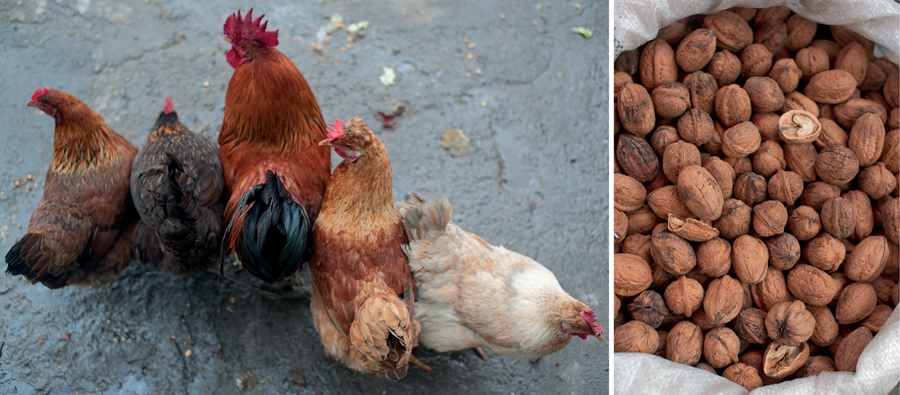
Left: Eastern Georgia—A rooster and four hens tethered at a village market.
Right: Tbilisi, Georgia—Walnuts for sale at one of the city’s many markets.